So, you’re thinking about switching your dog to a raw diet? That’s a smart move. I used to think it was just another trendy pet idea.
But after seeing my dog become more energetic and healthier on raw food, I can say it’s worth a try.
Here’s the deal: creating a balanced raw diet isn’t just about tossing chicken scraps in a bowl. It’s about mixing the right proteins, fats, vitamins, and minerals.
This way, your pup can thrive, not just survive. And don’t worry; it doesn’t have to be complicated or pricey. Stick with me, and I’ll break it down step by step in an easy way.
Why Raw Diets Work So Well
Ever wondered why dogs on raw diets seem to radiate health? It comes down to feeding them the way nature intended.
In the wild, dogs didn’t munch on kibble pellets. They ate whole prey: meat, bones, organs, and the occasional greens.
When you switch to raw:
- Their coats shine like they’ve been through a luxury spa.
- Their teeth get cleaner (no more stinky dog breath, thank you very much).
- Their digestion often improves, meaning smaller, less smelly poops.
Of course, not every dog is the same. Some might need adjustments, but the overall benefits make raw feeding a game-changer.
The Core Building Blocks of a Raw Diet
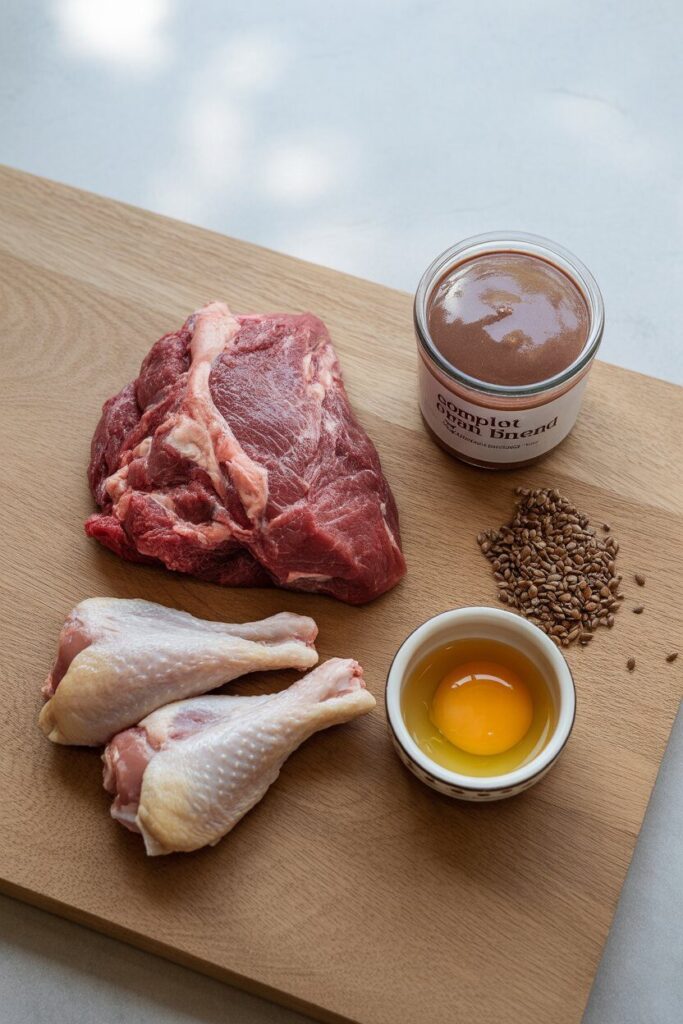
If you want your dog to thrive, you need to cover all the nutritional bases. Think of it like putting together a puzzle—miss a piece, and the picture looks off.
1. Muscle Meat
This is the bulk of the diet. Chicken thighs, beef chunks, turkey breast—you name it. Muscle meat provides protein and energy. Without it, your pup won’t build muscle or maintain strength.
2. Raw Edible Bones
Before you freak out, yes, raw bones are safe (cooked bones are the dangerous ones). Raw bones provide calcium and phosphorus, which keep teeth strong and bones healthy. Think chicken wings, necks, or beef ribs.
3. Organs
This is where the magic happens. Organs are nutrient-dense, like multivitamins in meat form. You’ll need:
- Liver for Vitamin A, B vitamins, and iron.
- Kidney or spleen for minerals like selenium and zinc.
Pro tip: Too much liver can cause vitamin A toxicity, so moderation is key.
4. Fruits and Veggies
I know, I know—dogs are carnivores, right? True, but adding some plant matter helps with fiber and micronutrients. Blend or lightly steam things like spinach, carrots, blueberries, and pumpkin.
5. Healthy Fats
Fats fuel your dog’s energy and keep their coat glossy. You can add fish oil, flaxseed oil, or feed fatty meats like salmon and mackerel.
The rule of thumb? Aim for a balance of about 70% muscle meat, 10% bone, 10% organs, and 10% fruits/veggies.
Discover top raw diet essentials your dog will love on Amazon
How to Get the Balance Right Easily
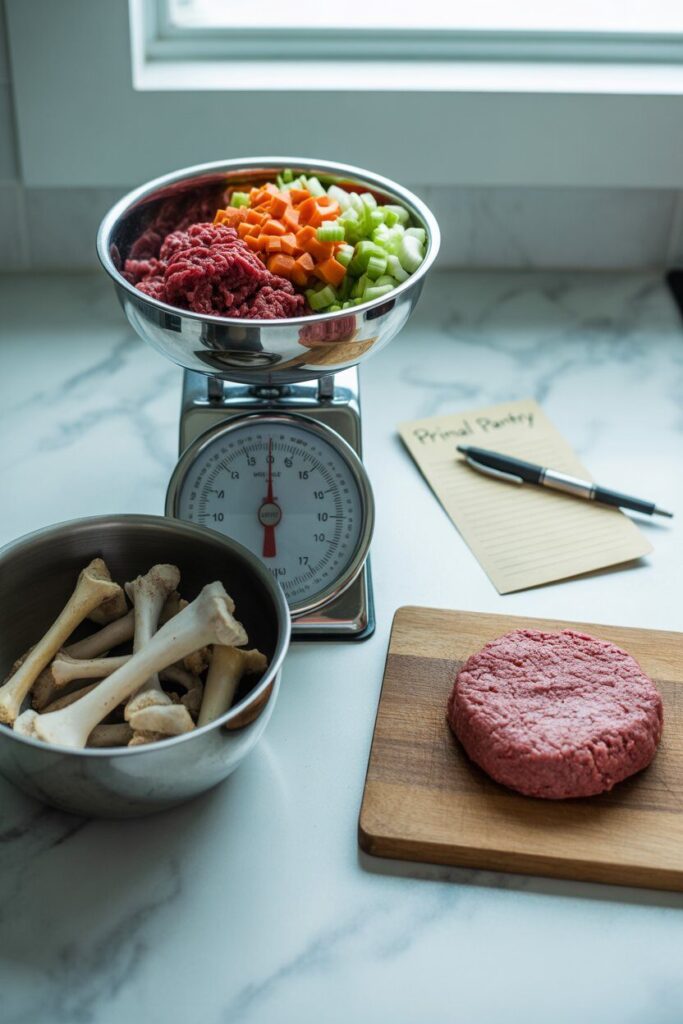
Here’s where most people panic. “What if I mess it up? What if my dog misses nutrients?” Relax. You don’t need a PhD in canine nutrition. Just follow these guidelines:
Rotate Proteins
Don’t just feed chicken every day. Mix it up with beef, lamb, turkey, or fish. Rotating proteins gives your dog a wider range of amino acids and prevents nutrient gaps.
Keep an Eye on Poop
Yes, I’m telling you to become a poop detective. Firm, small, non-smelly poop = balance. Chalky poop? Too much bone. Loose stool? Too much organ or fat. Simple checks can tell you more than you think.
Use Supplements (When Needed)
Sometimes food alone doesn’t cut it. Consider adding:
- Fish oil for omega-3s.
- Vitamin E to balance fish oil.
- Kelp powder for trace minerals.
Not every dog needs supplements, but they’re a nice backup plan.
Sample Raw Meal Plan
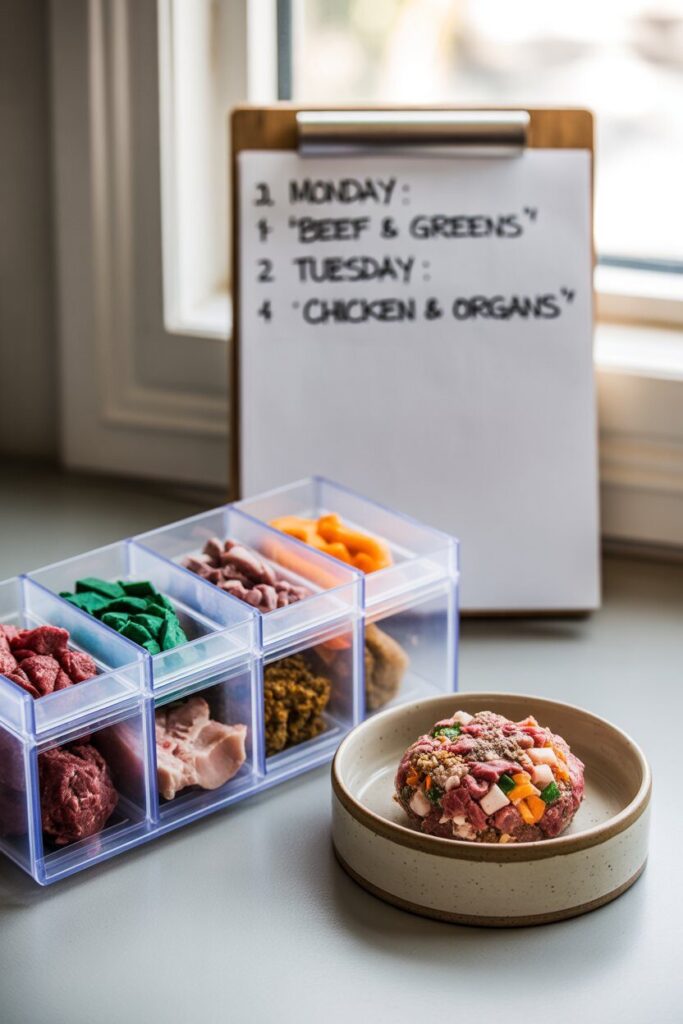
Okay, let’s get practical. Here’s an easy one-day meal plan for a medium-sized dog:
- Breakfast: Chicken necks (for bone) + beef heart (for muscle and taurine).
- Dinner: Ground turkey + liver + a small blend of spinach and pumpkin.
- Snack: A raw egg with shell (yes, the shell too—it’s full of calcium).
See? Not rocket science. And honestly, your dog will probably thank you by drooling all over the floor.
Shop the best raw feeding products for your pup today on Amazon
Common Mistakes People Make
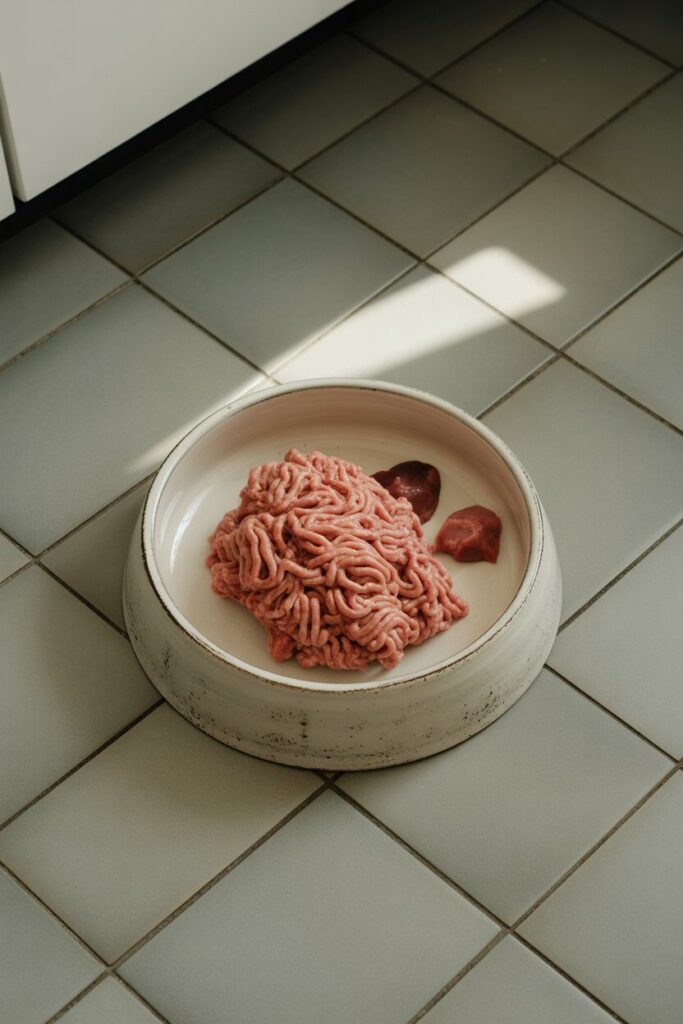
Even the best intentions can backfire. Here are the most common raw feeding blunders and how to avoid them.
Feeding Only Meat
If you toss plain chicken breast in a bowl every day, your dog will miss out on calcium, fats, and vitamins. Balance is everything.
Overdoing Organs
Yes, organs are nutrient bombs, but too much will give your dog diarrhea faster than you can say “oops.” Stick to the 10% rule.
Forgetting Variety
Dogs need different proteins and nutrients. Imagine if you ate only rice and beans forever—boring and unbalanced.
Skipping Safety Rules
- Always freeze meat for at least 48 hours before feeding to kill parasites.
- Wash bowls daily.
- Handle raw meat the same way you would for yourself.
Tips to Make Raw Feeding Affordable
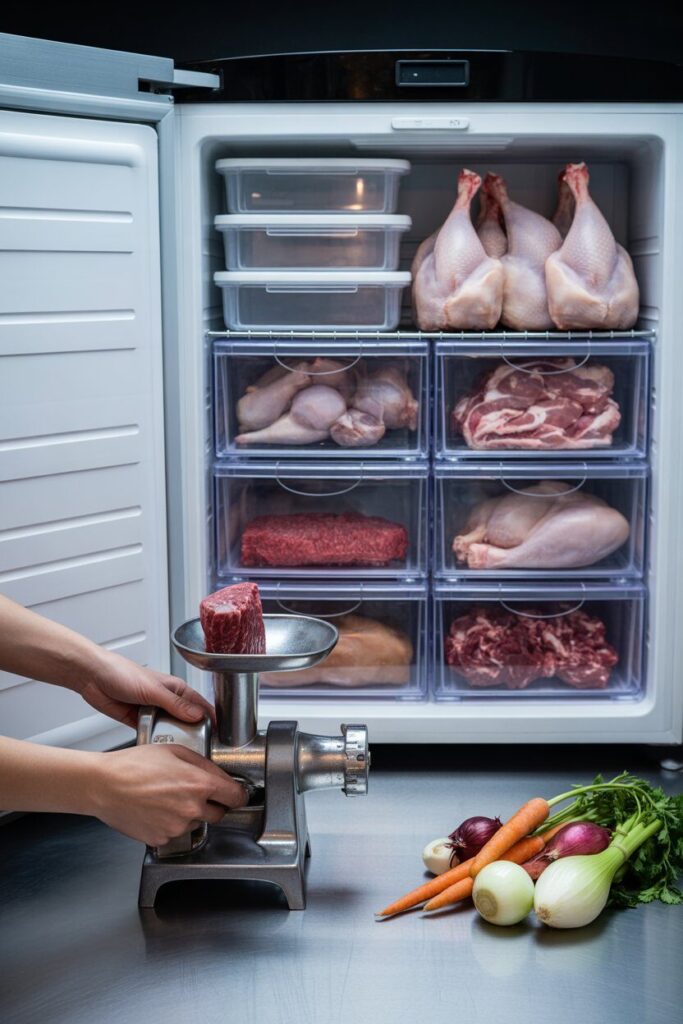
I won’t lie—raw feeding can get pricey if you’re not smart. But you don’t need to break the bank.
- Buy in bulk: Grab family packs of chicken, turkey, or beef when they’re on sale.
- Check local butchers: They often sell organ meats dirt cheap.
- Use seasonal produce: Cheaper, fresher, and just as healthy.
- Join co-ops or raw feeding groups: You’d be surprised how many people swap tips and deals.
Ever heard of people getting freezer space just for their dog’s food? Yeah, that’s a thing. And honestly, it saves money in the long run.
Check trusted raw diet supplies that pet owners recommend, available on Amazon
Transitioning Your Dog to Raw
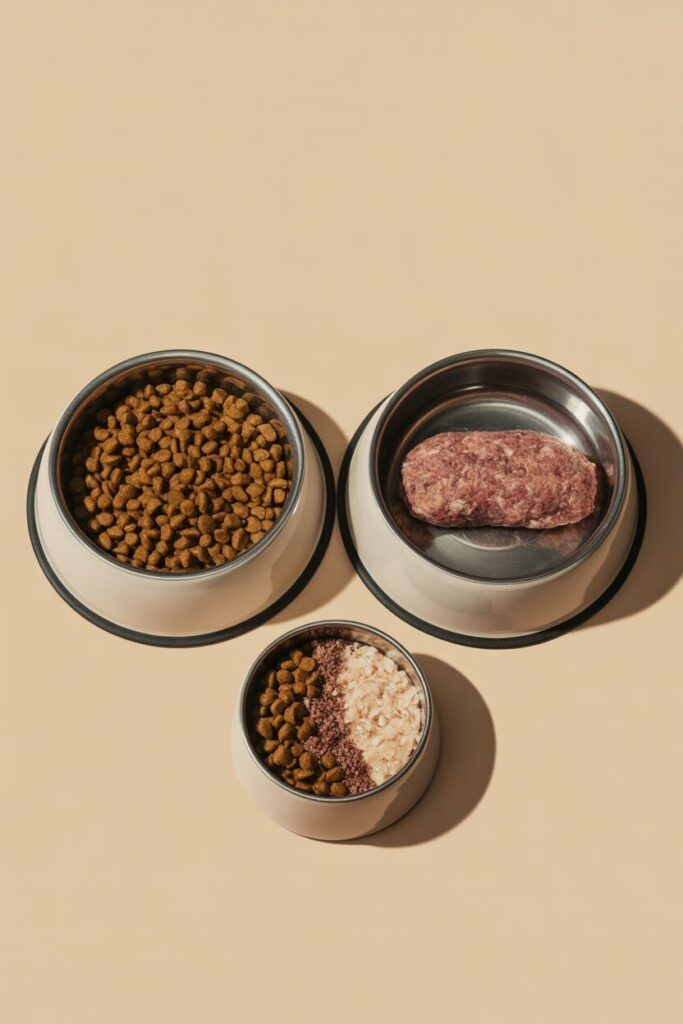
Switching from kibble to raw isn’t a “one-day flip.” You need to transition slowly.
Step 1: Start Small
Introduce raw meals once a day while keeping kibble for the other meal.
Step 2: Watch and Adjust
Keep an eye on digestion, energy levels, and stool. Adjust bone, fat, or organ content as needed.
Step 3: Go All-In
Once your dog adjusts, switch fully to raw. Most dogs adapt within 1–2 weeks.
Some dogs might detox a bit, meaning they shed more or have slightly runny stools at first. Don’t panic—it’s normal.
Is Raw Right for Every Dog?
Short answer: not always. Some dogs thrive on raw, while others need modifications.
- Puppies? Absolutely, but you’ll need to adjust portions since they’re growing fast.
- Seniors? Yes, but keep fat moderate since older dogs can gain weight easily.
- Dogs with health issues? Check with your vet first. Some conditions need special diets.
IMO, most dogs do great on raw, but like with people, one size doesn’t fit all.
My Personal Experience with Raw Feeding
Let me share a quick story. My lab mix, Max, used to have constant skin allergies. I tried everything—different kibble brands, expensive shampoos, endless vet visits.
Nothing worked. Finally, out of desperation, I tried raw feeding. Within three weeks, his skin cleared, and he had way more energy.
Now, was it magical overnight? Nope. I made mistakes, like feeding too much liver at first (let’s just say cleanup wasn’t fun). But once I nailed the balance, Max’s health transformed.
That’s why I tell people: raw feeding isn’t just a fad. It’s giving your dog what their body actually craves.
Conclusion
Building a balanced raw dog diet doesn’t have to feel overwhelming. Start with the basics—muscle meat, bones, organs, veggies, and fats. Rotate proteins, watch your dog’s poop, and adjust as you go. It’s that simple.
Yes, you’ll make mistakes at first (trust me, I did), but your dog will still benefit from the effort. And once you see the changes—brighter eyes, cleaner teeth, more energy—you’ll wonder why you didn’t start sooner.
So, are you ready to ditch the kibble and build a healthier, fresher plate for your dog? Your pup’s tail-wagging gratitude might just be the best reward you’ll get.
What Is the Right Ratio for a Balanced Raw Dog Diet?
The 70/10/10/10 rule is a common guideline: 70% muscle meat, 10% bone, 10% organs, and 10% fruits and veggies. This mix provides your dog with essential protein, minerals, and micronutrients.
However, this isn’t a fixed rule. Some dogs may require more bone for firmer stools or extra fat for energy. Always watch how your dog reacts to meals and make small changes as needed.
Can Puppies Eat a Raw Diet Safely?
Yes, puppies can thrive on a raw diet, but they need the right balance. They require more protein, fat, and calcium than adults. Feeding whole raw bones, organ meats, and fatty cuts helps them grow well.
Portion control and variety are key. Puppies eat more relative to their weight, so rotate proteins and keep meals rich in nutrients. If unsure, consult your vet to adjust portions as they grow.
Do Dogs Need Vegetables in Their Raw Diet?
Dogs don’t need vegetables to survive, but they can help. Veggies add fiber, antioxidants, and extra nutrients. This boosts digestion and immunity. Think of them as a healthy bonus, not a diet base.
Good choices are spinach, carrots, pumpkin, and broccoli. Lightly steaming or blending them helps your dog digest better. Raw veggies can be hard for their stomachs to handle.
How Do I Transition My Dog from Kibble to Raw?
The best approach is to go slow. Start by replacing one meal a day with raw food. Keep kibble for the other meal. This lets your dog’s digestive system adjust.
After a week or two, increase the raw food amount until you’re fully transitioned. Monitor your dog’s poop, energy, and appetite. Some dogs adapt quickly, while others take more time. Patience is key.
Is a Raw Diet More Expensive Than Kibble?
It depends on your approach. Premium kibble can cost as much, or more, than buying raw meats and organs in bulk.
Shopping smart—like buying family packs, using local butchers, and freezing portions—can help keep costs down.
Consider it an investment. A raw diet can lead to fewer vet visits, healthier coats, and better digestion. While the initial effort may be higher, the long-term benefits usually outweigh the costs.
